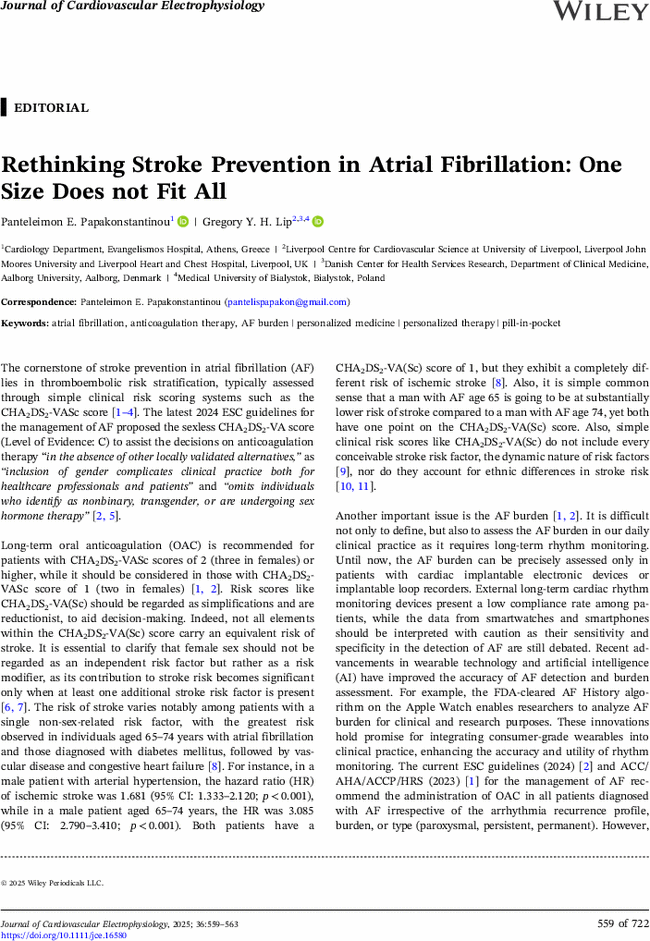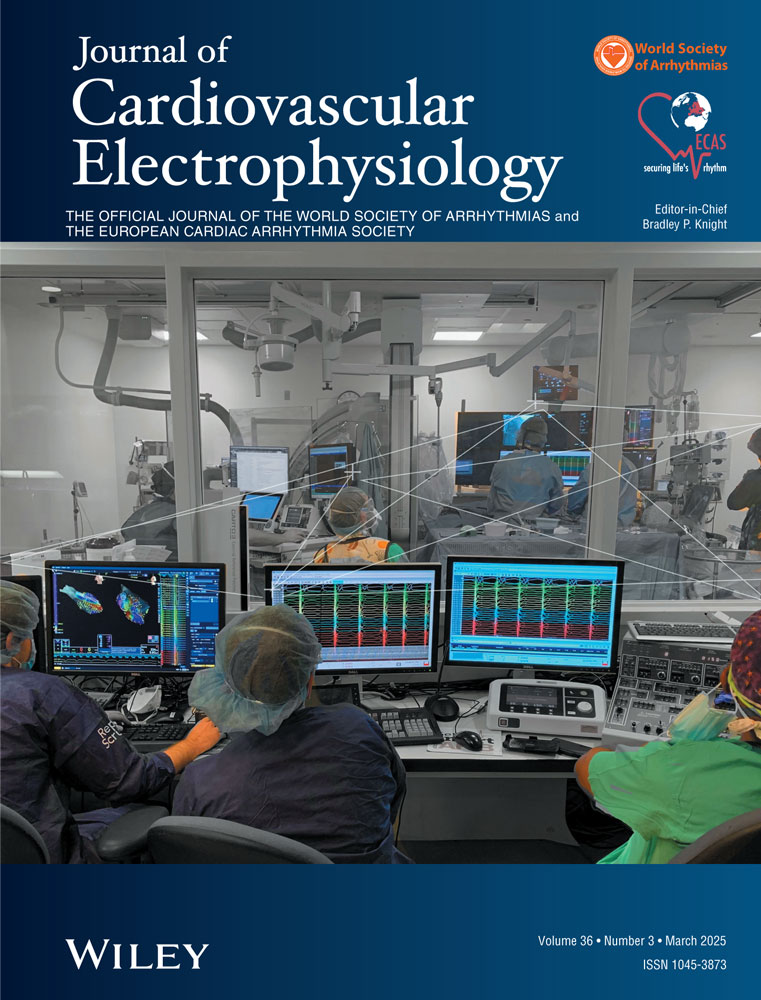Rethinking Stroke Prevention in Atrial Fibrillation: One Size Does not Fit All
Corresponding Author
Panteleimon E. Papakonstantinou
Cardiology Department, Evangelismos Hospital, Athens, Greece
Correspondence: Panteleimon E. Papakonstantinou ([email protected])
Search for more papers by this authorGregory Y. H. Lip
Liverpool Centre for Cardiovascular Science at University of Liverpool, Liverpool John Moores University and Liverpool Heart and Chest Hospital, Liverpool, UK
Danish Center for Health Services Research, Department of Clinical Medicine, Aalborg University, Aalborg, Denmark
Medical University of Bialystok, Bialystok, Poland
Search for more papers by this authorCorresponding Author
Panteleimon E. Papakonstantinou
Cardiology Department, Evangelismos Hospital, Athens, Greece
Correspondence: Panteleimon E. Papakonstantinou ([email protected])
Search for more papers by this authorGregory Y. H. Lip
Liverpool Centre for Cardiovascular Science at University of Liverpool, Liverpool John Moores University and Liverpool Heart and Chest Hospital, Liverpool, UK
Danish Center for Health Services Research, Department of Clinical Medicine, Aalborg University, Aalborg, Denmark
Medical University of Bialystok, Bialystok, Poland
Search for more papers by this author
Conflicts of Interest
P.E.P. reports consultancy for Boehringer Ingelheim and was an investigator in the Bayer-sponsored OCEANIC-AF study. G.Y.H.L. is a consultant and speaker for BMS/Pfizer, Boehringer Ingelheim, Daiichi-Sankyo, Anthos. No fees are received personally. He is a National Institute for Health and Care Research (NIHR) Senior Investigator and co-PI of the AFFIRMO project on multimorbidity in AF (grant agreement No. 899871), TARGET project on digital twins for personalized management of atrial fibrillation and stroke (grant agreement No. 101136244) and ARISTOTELES project on artificial intelligence for management of chronic long term conditions (grant agreement No. 101080189), which are all funded by the EU's Horizon Europe Research & Innovation program.
Open Research
Data Availability Statement
The data that support the findings of this study are available from the corresponding author upon reasonable request.
References
- 1J. A. Joglar, M. K. Chung, A. L. Armbruster, et al., “2023 ACC/AHA/ACCP/HRS Guideline for the Diagnosis and Management of Atrial Fibrillation: A Report of the American College of Cardiology/American Heart Association Joint Committee on Clinical Practice Guidelines,” Circulation 149, no. 1 (2024): e1–e156.
- 2I. C. Van Gelder, M. Rienstra, K. V. Bunting, et al., “2024 ESC Guidelines for the Management of Atrial Fibrillation Developed in Collaboration With the European Association for Cardio-Thoracic Surgery (EACTS): Developed by the Task Force for the Management of Atrial Fibrillation of the European Society of Cardiology (ESC), With the Special Contribution of the European Heart Rhythm Association (EHRA) of the ESC. Endorsed by the European Stroke Organisation (ESO),” European Heart Journal 45, no. 36 (2024): 3314–3414.
- 3Y. Wang, Y. Guo, M. Qin, et al., “2024 Chinese Expert Consensus Guidelines on the Diagnosis and Treatment of Atrial Fibrillation in the Elderly, Endorsed by Geriatric Society of Chinese Medical Association (Cardiovascular Group) and Chinese Society of Geriatric Health Medicine (Cardiovascular Branch): Executive Summary,” Thrombosis and Haemostasis 124, no. 10 (2024): 897–911.
- 4T. F. Chao, B. Joung, Y. Takahashi, et al., “2021 Focused Update Consensus Guidelines of the Asia Pacific Heart Rhythm Society on Stroke Prevention in Atrial Fibrillation: Executive Summary,” Thrombosis and Haemostasis 122, no. 1 (2022): 020–047.
- 5T. Potpara, G. F. Romiti, and C. Sohns, “The 2024 European Society of Cardiology Guidelines for Diagnosis and Management of Atrial Fibrillation: A Viewpoint From a Practicing Clinician's Perspective,” Thrombosis and Haemostasis 124, no. 12 (2024): 1087–1094.
- 6P. B. Nielsen and T. F. Overvad, “Female Sex as a Risk Modifier for Stroke Risk in Atrial Fibrillation: Using CHA2DS2-VASc Versus CHA2DS2-VA for Stroke Risk Stratification in Atrial Fibrillation: A Note of Caution,” Thrombosis and Haemostasis 120, no. 6 (2020): 894–898.
- 7B. Corica, T. Lobban, M. True Hills, M. Proietti, and G. F. Romiti, “Sex as a Risk Factor for Atrial Fibrillation-Related Stroke,” Thrombosis and Haemostasis 124, no. 4 (2024): 281–285.
- 8T. F. Chao, C. J. Liu, K. L. Wang, et al., “Should Atrial Fibrillation Patients With 1 Additional Risk Factor of the CHA2DS2-VASc Score (Beyond Sex) Receive Oral Anticoagulation?,” Journal of the American College of Cardiology 65, no. 7 (2015): 635–642.
- 9M. J. Serna, J. M. Rivera-Caravaca, R. López-Gálvez, et al., “Dynamic Assessment of CHA(2)DS(2)-VASc and Has-Bled Scores for Predicting Ischemic Stroke and Major Bleeding in Atrial Fibrillation Patients,” Revista Española de Cardiología 77, no. 10 (2024): 835–842.
- 10T. F. Chao, G. Y. H. Lip, C. J. Liu, et al., “Validation of a Modified CHA2DS2-VASc Score for Stroke Risk Stratification in Asian Patients With Atrial Fibrillation: A Nationwide Cohort Study,” Stroke 47, no. 10 (2016): 2462–2469.
- 11D. S. Kang, P. S. Yang, D. Kim, et al., “Racial Differences in Ischemic and Hemorrhagic Stroke: An Ecological Epidemiological Study,” Thrombosis and Haemostasis 124 (2024): 883–892.
- 12E. N. Simantirakis, P. E. Papakonstantinou, E. Kanoupakis, G. I. Chlouverakis, S. Tzeis, and P. E. Vardas, “Recurrence Rate of Atrial Fibrillation After the First Clinical Episode: A Prospective Evaluation Using Continuous Cardiac Rhythm Monitoring,” Clinical Cardiology 41, no. 5 (2018): 594–600.
- 13J. S. Healey, S. J. Connolly, M. R. Gold, et al., “Subclinical Atrial Fibrillation and the Risk of Stroke,” New England Journal of Medicine 366, no. 2 (2012): 120–129.
- 14M. P. Turakhia, P. D. Ziegler, S. K. Schmitt, et al., “Atrial Fibrillation Burden and Short-Term Risk of Stroke,” Circulation. Arrhythmia and electrophysiology 8, no. 5 (2015): 1040–1047.
- 15D. E. Singer, P. D. Ziegler, J. L. Koehler, S. Sarkar, and R. S. Passman, “Temporal Association Between Episodes of Atrial Fibrillation and Risk of Ischemic Stroke,” JAMA Cardiology 6, no. 12 (2021): 1364–1369.
- 16D. P. Zipes, “Atrial Fibrillation. A Tachycardia-Induced Atrial Cardiomyopathy,” Circulation 95, no. 3 (1997): 562–564.
- 17O. B. Vad, L. M. Monfort, C. Paludan-Müller, et al., “Rare and Common Genetic Variation Underlying Atrial Fibrillation Risk,” JAMA Cardiology 9, no. 8 (2024): 732–740.
- 18M. R. L. Tubeeckx, G. W. De Keulenaer, H. Heidbuchel, and V. F. M. Segers, “Pathophysiology and Clinical Relevance of Atrial Myopathy,” Basic Research in Cardiology 119, no. 2 (2024): 215–242.
- 19M. Packer, “Characterization, Pathogenesis, and Clinical Implications of Inflammation-Related Atrial Myopathy as an Important Cause of Atrial Fibrillation,” Journal of the American Heart Association 9, no. 7 (2020): e015343.
- 20M. J. Shen, R. Arora, and J. Jalife, “Atrial Myopathy,” JACC: Basic to Translational Science 4, no. 5 (2019): 640–654.
- 21W. Y. Ding, D. Gupta, and G. Y. H. Lip, “Atrial Fibrillation and the Prothrombotic State: Revisiting Virchow's Triad in 2020,” Heart 106, no. 19 (2020): 1463–1468.
- 22H. Kamel, W. T. Longstreth, D. L. Tirschwell, et al., “Apixaban to Prevent Recurrence After Cryptogenic Stroke in Patients With Atrial Cardiopathy: The Arcadia Randomized Clinical Trial,” Journal of the American Medical Association 331, no. 7 (2024): 573–581.
- 23I. C. Van Gelder, J. S. Healey, H. J. G. M. Crijns, et al., “Duration of Device-Detected Subclinical Atrial Fibrillation and Occurrence of Stroke in ASSERT,” European Heart Journal 38, no. 17 (2017): 1339–1344.
- 24T. V. Glotzer, A. S. Hellkamp, J. Zimmerman, et al., “Atrial High Rate Episodes Detected by Pacemaker Diagnostics Predict Death and Stroke: Report of the Atrial Diagnostics Ancillary Study of the Mode Selection Trial (MOST),” Circulation 107, no. 12 (2003): 1614–1619.
- 25T. V. Glotzer, E. G. Daoud, D. G. Wyse, et al., “The Relationship between Daily Atrial Tachyarrhythmia Burden From Implantable Device Diagnostics and Stroke Risk: The Trends Study,” Circulation: Arrhythmia and Electrophysiology 2, no. 5 (2009): 474–480.
- 26P. Kirchhof, T. Toennis, A. Goette, et al., “Anticoagulation With Edoxaban in Patients with Atrial High-Rate Episodes,” New England Journal of Medicine 389, no. 13 (2023): 1167–1179.
- 27J. S. Healey, R. D. Lopes, C. B. Granger, et al., “Apixaban for Stroke Prevention in Subclinical Atrial Fibrillation,” New England Journal of Medicine 390, no. 2 (2024): 107–117.
- 28W. F. McIntyre, A. P. Benz, N. Becher, et al., “Direct Oral Anticoagulants for Stroke Prevention in Patients With Device-Detected Atrial Fibrillation: A Study-Level Meta-Analysis of the NOAH-AFNET 6 and ARTEsiA Trials,” Circulation 149, no. 13 (2024): 981–988.
- 29P. E. Papakonstantinou and E. N. Simantirakis, “Long-Term Rhythm Monitoring With an Implantable Loop Recorder in Patients After the First Clinical Atrial Fibrillation Episode. Towards an Individualized Management,” Minerva Cardioangiologica 67, no. 2 (2019): 121–130.
- 30D. T. Martin, M. M. Bersohn, A. L. Waldo, et al., “Randomized Trial of Atrial Arrhythmia Monitoring to Guide Anticoagulation in Patients With Implanted Defibrillator and Cardiac Resynchronization Devices,” European Heart Journal 36, no. 26 (2015): 1660–1668.
- 31R. Passman, P. Leong-sit, A. C. Andrei, et al., “Targeted Anticoagulation for Atrial Fibrillation Guided by Continuous Rhythm Assessment With an Insertable Cardiac Monitor: The Rhythm Evaluation for Anticoagulation With Continuous Monitoring (REACT.COM) Pilot Study,” Journal of Cardiovascular Electrophysiology 27, no. 3 (2016): 264–270.
- 32J. W. Waks, R. S. Passman, J. Matos, et al., “Intermittent Anticoagulation Guided By Continuous Atrial Fibrillation Burden Monitoring Using Dual-Chamber Pacemakers and Implantable Cardioverter-Defibrillators: Results From the Tailored Anticoagulation for Non-Continuous Atrial Fibrillation (TACTIC-AF) Pilot Study,” Heart Rhythm: The Official Journal of the Heart Rhythm Society 15, no. 11 (2018): 1601–1607.
- 33G. Peigh and R. S. Passman, ““Pill-In-Pocket” Anticoagulation for Stroke Prevention in Atrial Fibrillation,” Journal of Cardiovascular Electrophysiology 34, no. 10 (2023): 2152–2157.
- 34P. E. Papakonstantinou and K. Tsioufis, “Optimizing Anticoagulation Management in Atrial Fibrillation: Beyond the Guidelines. How and for Whom?,” Journal of Cardiovascular Pharmacology 81, no. 6 (2023): 397–399.
- 35P. E. Papakonstantinou, V. Kalogera, D. Charitos, et al., “When Anticoagulation Management in Atrial Fibrillation Becomes Difficult: Focus on Chronic Kidney Disease, Coagulation Disorders, and Cancer,” Blood Reviews 65 (2024): 101171.
- 36Y. Guo, “A New Paradigm of “Real-Time” Stroke Risk Prediction and Integrated Care Management in the Digital Health Era: Innovations Using Machine Learning and Artificial Intelligence Approaches,” Thrombosis and Haemostasis 122, no. 1 (2022): 005–007.
- 37G. Y. H. Lip, A. Genaidy, G. Tran, P. Marroquin, C. Estes, and S. Sloop, “Improving Stroke Risk Prediction in the General Population: A Comparative Assessment of Common Clinical Rules, a New Multimorbid Index, and Machine-Learning-Based Algorithms,” Thrombosis and Haemostasis 122, no. 1 (2022): 142–150.




